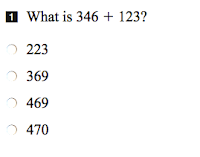Two questions that I found particularly interest in last year's Junior EQAO were these:

Again, when I show this to teachers, principals and parents, I ask them to predict what percentage of students they think got these correct. For the first question, bearing in mind that primary students struggled with a similar equality question, typically people reckon that about 50% of students got this correct.
The actual amount provincially is 68% and the breakdown for each response is shown below.
To an extent, this is encouraging: It would appear that students have a better understanding of the meaning of the '=' sign than their primary counterparts and chatting to a small number of junior students would at least anecdotally confirm this. From a number sense point of view, it would appear that many of them are comfortable enough to work with both a subtraction that might involve regrouping and a multiplication that requires one of the more commonly mistaken facts (i.e. 8×7=56). A very small minority (those who answered 11) appear to have added 72 and 16 instead of finding the difference. And there is another group who have answered 56. Now this maybe because they have misconceptions with the '=' sign and simply answered 72–16. But I have also seen both students and adults do something like this:
...and for whatever reason selected the 56 option in the answer key. When I saw one parent do this at one of our Math Café for parents, I asked them to tell me the value of m. They correctly told me 7. I then asked them, what answer they selected. Again they answered 7, so I asked them to look at what they had actually written. When they saw they had selected 56, they were stunned and said "How on earth did I put that?".
It made me realise that just because somebody puts the wrong answer down on a multiple choice test, doesn't mean to say that they don't understand what to do.
The second question was the answered correctly by the lowest number of junior students (34%). The actual breakdown is shown below:
It is classified as a measurement question but my sense is that the errors that are being made here are not to do with how many millilitres are in a litre. The mistakes are made because students (and adults) need to decide which operations to use. They have deficits in their operational understanding. If students are told what operation to use (e.g. calculate 45+99, work out 2496÷24) then this is computational understanding which, though useful, does not prepare them to answer the milk question. If students experience a diet of nothing but computational questions then they will always have difficulties when they have to decide what operations to use. Doing a hundred long division questions will not teach students what division is and when it should be used.
But also, if students are just given one-step word problems where they have to decide on what single operation to use, then this will not be enough to prepare them for the question above: two of the answers above are the result of students most likely selecting a single operation (6×4=24, and 250÷4=62.5≈63).
Perhaps a strategy that I would avoid at all costs is the keyword approach. Here students are taught a list of words and their accompanying operation. One of the problems with this approach is that sometimes these keywords are not present in the question (are there any keywords in the example above?). Additionally, I have seen students read a question, write down two numbers involved then an operation suggested by the keyword regardless of whether or not this makes sense:
In terms of how to develop operational understanding, my go to is always the concrete-diagrammatic-symbolic approach. It was interesting to see how adults tackled this question when I gave it to them. Some are surprised that this is on the junior EQAO as they think (rightly or not) that it is too difficult. There were more than a few who struggled to figure out what operations to use until they tried drawing a diagram: then the operations required became clearer. This is one of the reasons why I like bar models (as I have blogged before here and here.)
As operations are in essence actions, any strategy that gets students thinking about the actions involved in the question will tend to be a good one.








